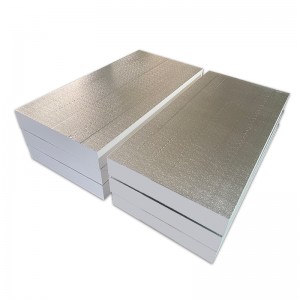Phenolic foam material is a polymer organic hard aluminum foil foam product, which is foamed by thermosetting phenolic resin. It is lightweight, fireproof, non flammable when exposed to open flames, smokeless, non-toxic, and non dripping. It has a wide temperature range (-190~+160 ℃) and does not shrink or embrittle in low temperature environments. Because of its high closed cell ratio, phenolic foam has low thermal conductivity (which can be lower than 0.025w/mk), good thermal insulation performance, and certain water resistance and water vapor permeability. It is a good thermal insulation and energy saving material, and also an ideal thermal insulation material for HVAC engineering. Due to the benzene ring structure of phenolic aldehyde, its size is stable with a change rate of<1%. And the chemical composition is stable, anti-corrosion and anti-aging, especially resistant to organic solutions, strong acids and weak alkalis. In the production process of foaming, the use of Freon as a foaming agent meets international environmental standards, and its molecular structure contains hydrogen, oxygen, and carbon elements. When decomposed at high temperature, the leaked gas is non-toxic and odorless, harmless to human health and the environment, and meets national green environmental protection requirements. Therefore, phenolic super composite board is an ideal environmentally friendly and green insulation material for fire prevention, insulation, energy conservation, and aesthetics.
Main technical parameters:
Unit weight 40-100kg/m3
Thickness 20-200mm
Thermal conductivity coefficient 0.020-0.025w/mk
Flame retardant grade B1
Smoke density level<5
Working temperature -190~+160 ℃
1. The defects of polyurethane: it is easy to burn and produce toxic gases when exposed to fire, posing a threat to human health;
2. The defects of polystyrene: it is easy to burn when exposed to fire, shrinks after prolonged use, and has poor insulation performance;
3. Defects of rock wool and glass wool: harmful to the environment, breeding bacteria, high water absorption rate, poor insulation effect, poor strength, and short service life;
4. The advantages of phenolic resin: non combustible, no toxic gas or smoke after combustion, low thermal conductivity, good insulation effect, sound insulation, good weather resistance, and a service life of up to 30 years;
5. It has uniform closed cell structure, low thermal conductivity, good thermal insulation performance, and is equivalent to polyurethane, superior to polystyrene foam;
6. The applicable temperature range is wide. It can be used at -200 ℃~200 ℃ in the short term and -190 ℃~160 ℃ in the long term, superior to polystyrene foam (80 ℃) and polyurethane foam (110 ℃);
7. Phenolic molecules only contain carbon, hydrogen, and oxygen atoms. When subjected to high-temperature decomposition, apart from producing a small amount of CO gas, no other toxic gases will be produced, with a maximum smoke density of 5.0%. The 25mm thick phenolic foam plate, after being sprayed with a flame at 1500 ℃ for 10min, only slightly carbonized on the surface but could not burn through, neither would it ignite nor emit thick smoke and toxic gas;
8. In addition to being corroded by strong alkali, phenolic foam is resistant to almost all inorganic acids, organic acids and organic solvents. Long term exposure to sunlight without obvious aging phenomenon, thus possessing good aging resistance;
9. The cost of phenolic foam is low, which is only two thirds of that of polyurethane foam.
Post time: Oct-27-2023

